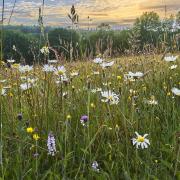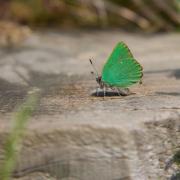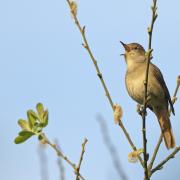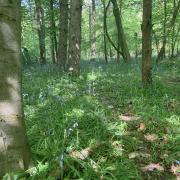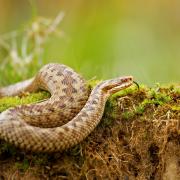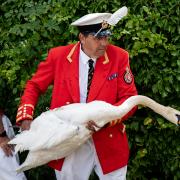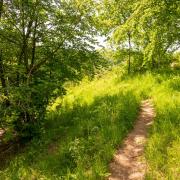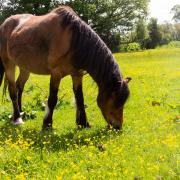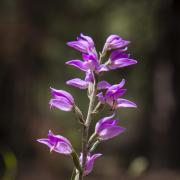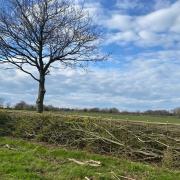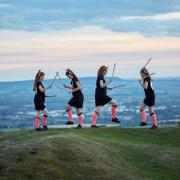Joe Meredith swapped the hills of the Cotswolds for the savannahs of South Africa’s Eastern Cape, discovering some of what makes the country such an exciting place to be

As we break out of the trees into a clearing, we reach a steep decline that jolts us forward towards Duma’s flapping ears.
“Have you ever fallen off?” I ask Shylock, the soft-spoken Zimbabwean guide sitting in front of me.
“Many times.”
Thankfully, Duma the elephant, whose name unnervingly means ‘thunder’ in Zulu, is in a good mood today. We ride the 27-year-old bull slowly around this perfectly quiet corner of Addo National Park, across well-trodden grass and between coarse vegetation. Duma’s thick grey skin is unscathed by the ubiquitous acacia karroo, a shrub armed with long white thorns that lines the route we are walking. In fact, the barbed menace is a favourite snack of the African elephant.

We had arrived at the Addo Elephant Park from Port Elizabeth, a pretty coastal city in the Eastern Cape. The ‘friendly city’, as it’s known, retains visible signs of its colonial history, with road signs pointing us to places such as New Brighton, Colchester – and even a suburb called Cotswold. Our insightful guide Neil Lyon explained that the ties to South Africa’s uncomfortable past provoked a recent protest movement targeting memorials to controversial figures such as Cecil Rhodes. It was clear the legacy of the British Empire was still having an impact on the politics of the country, more than 80 years after its independence.
As the Indian Ocean and urban sprawl of Port Elizabeth dipped out of view, we passed the small township houses of Motherwell. The long stretch of road that followed was bordered by rows of little orange trees, nestled in the citrus orchards of the Sundays River Valley. Then on to a winding rocky trail around the lush Zuurberg Mountains, glimpsing the occasional vervet monkey bounding across the road into the bushes, before our arrival at the Addo Elephant Safari.
“Trunk up.”
Duma obliged; his long trunk raised and rested upon his head. I placed the food pellets onto his enormous pink tongue as the trainer snapped the perfect picture. Our elephant-back safari was followed by a walk on foot alongside the elephants, and we were now indulging them with food by the bucket-full. The latter activity seemed more focused on the photo opportunity than enjoying the company of the animals, but the overall experience gives you a chance to come face-to-face with one of the Big Five and appreciate the unique, furrowed beauty of the African elephant.

Whilst you can’t get much closer to an elephant than sitting on one, it wasn’t until we were on horseback that we had the opportunity to appreciate the range of wildlife South Africa has to offer. In the Nyati section of Addo Elephant National Park, visitors have a chance to ride along safari trails in a small horse cavalcade. My humble steed, hand-picked for a beginner rider such as myself, was called Girly (I didn’t take it personally), and seemed more interested in eating whatever was under-hoof than enjoying the wildlife.
“I don’t think you’ll be able to pronounce my full name, so call me Mr X,” said the stout South African ranger clad in pine-green gear, armed with a rifle in case the odd lion turned up. He led the procession as we gently manoeuvred around the open fields on horseback, often trotting within a stone’s throw of grazing animals including zebra and red hartebeest. Warthogs skipped by herds of eland, South Africas largest antelope, as we passed the sun-bleached empty shell of a tortoise. The hour or so riding Girly proved a surprisingly relaxing way to roam a little patch of South Africa’s landscape without the aid of four wheels.
An hour’s drive east of Addo lies the Amakhala Game Reserve, a proudly ‘malaria-free’ conservancy of about 18000 acres in total, where all seven of South Africa’s biomes are maintained, from forest to thicket. We were staying at the four-star Safari Lodge on site, with its quirky stone-capped, thatch-roofed huts blending in beautifully with the environment. Every creature from rhino to cheetah call this place home, and game drives at Amakhala involve bumping around in a robust, open-top land rover across the reserve’s uneven trails to see what critters you can spot.
We returned after one such jaunt by way of an atmospheric night drive, the occasional glinting eyes of nocturnal scrub hares sparkling in the dark at us. Under a deep black sky, with a view of the Milky Way the envy of city-dwellers the world-over, we caught our first and only glimpse of Africa’s most famous predator - the lion. The big cat, so symbolic of Africa that its regal façade is emblazoned on the fifty rand note, is facing a threat greater than poaching. The African grasslands have been steadily shrinking, and this loss of habitat has contributed to the 65% decline in lion numbers since the 1960s. If current trends persist, the lion, along with the other great animals of this continent, may not be around for future generations to enjoy. So, as this particular lion reclined beside the dirt road, his mane aglow in the gaze of our headlights, I felt privileged.

You can do more than just go on safari in the Eastern Cape, however. About 170 miles west of Amakhala, the Tsitsikamma Mountains scrape the sky with their jutting peaks of forest-covered sandstone. In amongst the range lies the imposingly large Bloukrans Bridge, straddling the border of the Western and Eastern Cape. An impressive sight by itself – but one of the best ways to appreciate the scale of the arch bridge, towering 216 metres above Bloukrans River, is to jump off it.
Face Adrenalin operates one of the highest commercial bungee jumps in the world, hidden just under the bridge road. The preface to the heart-in-your-mouth moment is the perfect build-up - a 200-metre walkway providing a view of the deep valley into which you’ll soon descend. Once we’d gathered at the jump point, the team strapped us into the necessary safety equipment. I shuffled to the edge of the precipice, toes dangling over, buoyed by the thought that, of all the places for a freak bungee accident to take place, this must be one of the most beautiful. An incongruous selection of R’n’B music boomed from a dedicated DJ booth behind me.
“Are you ready?” a member of the Face Adrenalin team asked wryly.
Gulp.

“5, 4, 3, 2, 1... Bungee!”
Somehow the most life-affirming moments are often those preceded by a deep sense of dread. Hurtling into the valley, with a view of the distant ocean, you’re very much ‘in the moment.’ The high hits you after the first bounce, and remains beyond the point when you’re winched back up to safe ground. My single jump pales in comparison to the 107 jumps fellow Briton Scott Huntly performed off the very same bridge in only nine hours, setting a new world record in 2011. But that’s just showing off. If bungee jumping is on your bucket list, as it was mine, there are few places as picturesque as Bloukrans to strike it off.

If you’re similarly averse to keeping your feet on the ground, but would rather dip them in the water than the clouds, you might enjoy a spot of kayaking in Tsitsikamma. The kayak and lido experience, run by Untouched Adventures, takes you on a journey up a short section of the Storms River. You paddle from the mouth of the river between the sheer rock cliffs of a gorge in two-man kayaks, pausing to admire the deep cave thousands of bats call home. Once you reach a section of bank, you swap kayaking for paddling on inflatable lidos, and there’s an optional cliff jump from a ledge around 20ft high into the crystal black water below.
Note: Make sure your paddle technique during the kayaking is fairly good (mine was not) and that you’re partnered with someone you can synchronise with stroke-for-stroke (I was not), or expect very tired arms afterwards! The activity is suitable for families, too, and there’s an on-site restaurant serving fresh seafood to replenish the calories you just burned off.

For a more traditional dining experience, there are plenty of opportunities to sample local cuisine around the Eastern Cape. Whether the popular dried and cured meat, biltong, or a braai - a traditional South African barbecue, meat is very much on the menu here. At our accommodation in Tsitsikamma Village Inn, we were treated to a fireside braai by Leon, an amiable dreadlocked chef we’d bumped into previously at the local tavern. Boerewors, a spiced sausage with Dutch heritage, and sosatie, the South African equivalent of a shish-kebab, joined marinated cuts of pork and beef on the grill. Our meal was washed down with Carling Black Label, the go-to beer of South Africans, as well as a little Amarula. Amarula is a popular cream liqueur with a similar viscosity and flavour to Baileys, but with the unique addition of the fruit of the African marula tree. Our guide, Neil, enjoyed introducing us naïve Brits to the so-called ‘Woman’s Revenge’; for a fairly unpleasant experience, drink a shot of Amarula followed immediately by a shot of lime cordial, and swish the mixture around in your mouth for 30 seconds before swallowing. You’ll quickly realise that revenge is a shooter best served curdled.
After our culinary adventure, the distant sound of Jamaican dancehall music booming from loudspeakers down an empty street promised off-itinerary entertainment. We inadvertently gate-crashed a neighbourly gathering by residents of the Storms River Village, but were generously treated to some locally brewed milk stout, before heading off to a nearby tavern with our newly acquired friends for a night out South African-style. We’d missed the regular Elvis-themed evening at the out-of-place 50s American diner nearby, but if you want to get a real impression of a country’s people, visit their local watering hole. It has to be said, there was far more dancing than you’d find at most pubs in the Cotswolds!
South Africa is still a nation struggling with the burden of a difficult history – but it’s also a nation with fascinating people, a rich culture, beautiful wildlife and some of the most exceptional views the planet has to offer. Foregoing the latter because of the former would be a tragedy, so whether you’re after high octane thrills or a more leisurely experience, a visit to the homeland of Mandela comes highly recommended.
----------------------
Thanks to Neil Lyon of Lyon Tours & Safaris, and Juan Herrada of South Africa Tourism. For more ideas on what to do in South Africa, visit www.southafrica.net




